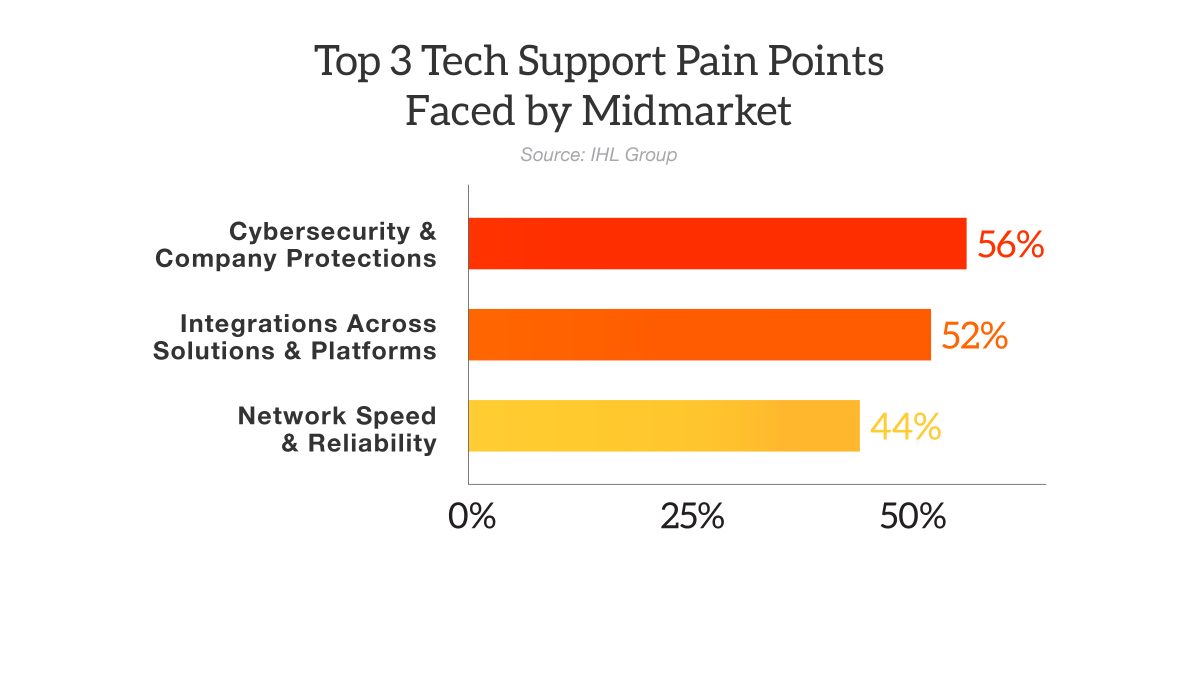Navigating the Security Landscape: Key Challenges for Medium-Sized Retailers

Medium-sized retail businesses often find themselves in a unique position. They have outgrown the vulnerabilities typical of small enterprises but have not yet achieved the more robust security infrastructure of their larger counterparts. This places them squarely in the crosshairs of cyber threats, making cybersecurity a critical concern for Chief Information Officers (CIOs) and Chief Information Security Officers (CISOs) in these organizations.
Recently IHL conducted a study about the challenges that small and medium businesses have related to security. You can download a copy for free here.
As we dove into the challenges faced by retailers with annual sales ranging from $10 million to $400 million, it became clear that the path to securing their operations is fraught with both unique hurdles and opportunities for strategic security enhancements. Below, let’s explore the major security challenges that medium-sized retailers encounter and propose strategies to navigate this complex landscape effectively.
1. Balancing Budget Constraints with Effective Security Measures
One of the most significant challenges is managing the delicate balance between budget constraints and the need for comprehensive security measures. Unlike larger corporations with more substantial budgets, mid-sized companies must often make tough decisions about where to allocate their limited resources. Investing in advanced cybersecurity technologies can be costly, and the return on investment is not always immediately apparent.
Strategy: To overcome this challenge, CIOs and CISOs should focus on cost-effective security solutions that offer the highest impact. Prioritizing investments in security measures that protect against the most common and damaging types of cyber-attacks, such as phishing and ransomware, can provide a more manageable starting point. Additionally, leveraging open-source tools and seeking out scalable security solutions can help manage costs without compromising critical protections.
2. Ensuring Compliance with Industry Regulations
Medium-sized retailers often operate under the same stringent regulatory frameworks as larger entities, such as PCI DSS for payment security, GDPR for data protection in Europe, and various other local data privacy laws. Compliance not only helps avoid legal penalties but also plays a crucial role in building trust with customers.
Strategy: Regular compliance audits and continuous monitoring of regulatory changes are essential. Implementing a robust compliance management system can streamline this process. It’s also beneficial to engage with legal and compliance experts who specialize in retail to ensure that all potential regulatory requirements are met efficiently. You may need to use outside partners to help with this process.
3. Managing Third-Party Risks
As retail businesses grow, they increasingly rely on third-party vendors for services ranging from payment processing to data storage. Each vendor introduces potential vulnerabilities into the security ecosystem, especially if their security measures are not up to par with the retailer’s standards.
Strategy: Implementing a comprehensive third-party risk management program is crucial. This includes conducting thorough security assessments before onboarding new vendors and regular reviews of existing vendors’ security practices. Establishing clear contractual agreements that include compliance with specific security requirements can also mitigate risks. Once again, this may require some outside help to help manage if you do not have the internal resources to complete.
4. Protecting Against Advanced Cyber Threats
Cybercriminals are continually evolving their tactics, and medium-sized retailers are often targeted with sophisticated cyber-attacks designed to penetrate standard security defenses. Advanced persistent threats (APTs), ransomware, and sophisticated phishing schemes are just a few examples of the types of attacks that can devastate a mid-sized retail business.
Strategy: Investing in advanced threat detection and response tools is key. Solutions like endpoint detection and response (EDR) and security information and event management (SIEM) systems can provide deeper insights into network activities and potential threats. Additionally, regular training sessions for employees on the latest cyber threats and best practices for security can significantly reduce the risk of successful attacks. The study details several examples of how the best performing companies are trying to address this issue.
5. Scaling Security with Business Growth
As companies, their IT infrastructure becomes more complex, and scaling security measures appropriately can be challenging. Ensuring that security grows in tandem with the business is crucial to protect expanding digital assets and customer data.
Strategy: Adopting a scalable security framework that can grow with the business is essential. Cloud-based security solutions can offer flexibility and scalability, adapting to changing business needs without requiring significant upfront investment in physical infrastructure.
6. Dealing with the Shortage of Skilled Cybersecurity Professionals
The cybersecurity industry is currently facing a significant talent shortage, and medium-sized retailers often struggle to attract and retain skilled cybersecurity professionals due to competition from larger companies offering more competitive salaries and benefits.
Strategy: Building a culture that values and invests in cybersecurity can help attract talent. Additionally, partnering with universities and cybersecurity training programs to develop internships and entry-level positions can create a pipeline of skilled professionals. Outsourcing certain security functions to specialized firms can also be an effective way to manage this challenge. Whether it is a managed services provider (MSP) or Managed Security Services Provider (MSSP), one key option is to look to outside partners who can not only help, but take full ownership if things go wrong.
Final thoughts
The journey towards robust cybersecurity is complex but navigable for small-medium sized retailers and restaurant chains. Understanding the unique challenges and implementing strategic solutions tailored to their specific needs, CIOs and CISOs can effectively safeguard their organizations against the evolving landscape of cyber threats. For more information on this topic and specific data from our research, download “Strategic Outsourcing – Cybersecurity & IT for Midmarket Companies”